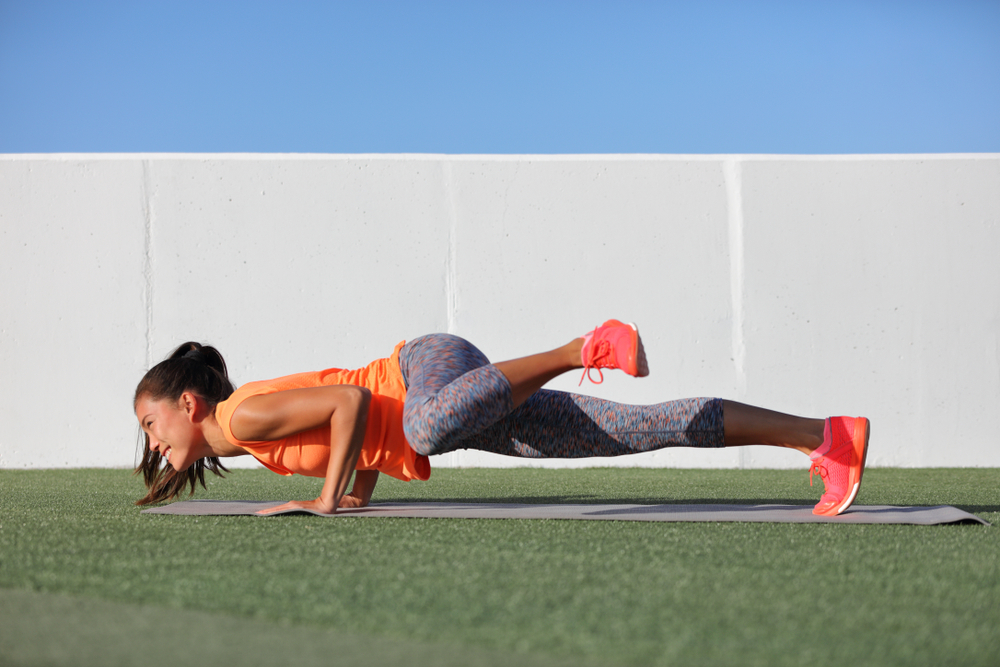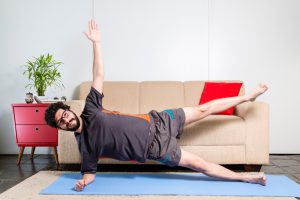The Spiderman pushup combines a standard pushup with a knee-to-elbow drive, where you bring one knee toward the outside of your elbow as you lower down, then alternate sides with each rep.
You should try it because it builds upper body strength while simultaneously challenging your core stability and hip mobility in ways traditional pushups simply can't match.
Keep reading for the complete breakdown of proper form, common mistakes to avoid, and how to program this exercise into your routine.
What Makes the Spiderman Pushup Different From Standard Variations
Most pushup variations zero in on upper body strength, but the Spiderman pushup takes a different approach.
This advanced bodyweight exercise—named after the superhero's signature wall-crawling motion—combines your standard pushup with a dynamic knee-to-elbow drive that happens simultaneously as you lower down.
Here's what sets it apart: you're balancing on just three points of contact throughout the movement.
As you descend into the pushup, one knee travels forward and outward toward the elbow on the same side.
This creates an entirely different stability demand compared to keeping both feet planted on the ground.
The real difference shows up in what you're training.
While traditional pushups hammer your chest, shoulders, and triceps, this variation forces your body to work through multiple ranges of motion at once.
You're building upper body strength while actively improving hip mobility—something most pushing exercises completely ignore.
Think of it as a multi-joint movement that mirrors how your body actually moves in real life.
Crawling across the floor, pushing yourself up from the ground, or any movement requiring coordination between your upper and lower body—the Spiderman pushup trains these patterns.
You're not just getting stronger in one plane of motion; you're developing the kind of functional strength that translates beyond the gym.
Six Compelling Reasons to Add This Exercise to Your Routine
Your core works harder than you think.
Standard pushups activate your obliques at around 30% of maximum voluntary contraction and your erector spinae at roughly 22%.
The Spiderman version cranks these demands up significantly.
Your body has to resist rotation, lateral flexion, and extension of both your spine and pelvis as one leg moves and three limbs support you.
This isn't just surface-level abs work.
The deep stabilizers—your transverse abdominis, obliques, and quadratus lumborum—fire far more intensely than during regular pushups.
You're fighting against rotational forces the entire time, which explains why this movement feels so different from anything else.
The strength benefits extend everywhere.
You'll hit your chest, shoulders, triceps, forearms, deltoids, and upper pecs, but the asymmetrical position creates unique demands on each side.
Your core engages to prevent rotation while your shoulders and arms work overtime to maintain control with reduced points of contact.
Hip mobility improves with every rep.
As your knee drives toward your elbow, your hip moves through both flexion and abduction—two ranges of motion that most people need to work on.
This active movement increases your hip's overall range of motion, making the exercise particularly valuable if you spend hours sitting at a desk each day.
Three more reasons to program this movement:
- Balance and coordination get sharper because you're controlling, stabilizing, and linking different muscle groups simultaneously while moving through a full range of motion
- Injury risk drops as dynamic exercises that combine strength, balance, and mobility have been shown to reduce injuries in athletes
- Your heart rate climbs since the dynamic nature of the movement adds a cardiovascular component alongside the strength work
You're essentially getting six benefits packaged into one exercise—and that's before you even consider the time efficiency.
Step-by-Step Execution Guide for Perfect Form
Set up your foundation. Start in a plank position with your hands slightly wider than shoulder distance, positioned directly underneath your shoulders.
Keep your feet together and create a straight line from your head to your heels.
Watch for two common setup errors: letting your hips sag toward the floor or piking them up toward the ceiling.
Neither works. You need a neutral spine from the start.
Lock in your core before you move. Brace your abdominal muscles, obliques, and lower back as if someone's about to punch you in the stomach.
Squeeze your glutes hard—this stabilizes your pelvis and prevents your hips from dropping as you fatigue.
Here's how the movement unfolds:
The descent: Take an inhale and reinforce that core brace.
Bend at your elbows, driving them at a 45-degree angle relative to your body—not flaring straight out to the sides.
As your torso lowers toward the mat until both arms form 90-degree angles, simultaneously bend one knee and draw it forward and outward toward the elbow on the same side.
The bottom position: Pause with your chest about an inch from the ground, keeping your chest parallel to the floor.
Your knee should reach the outside of your elbow with your thigh roughly parallel to the ground.
Hold this for a beat.
The ascent: Push through your chest and extend your elbows to return to the starting position.
At the same time, extend your knee and bring your leg back to the original position.
Alternate sides with each rep—right knee to right elbow on one rep, left knee to left elbow on the next.
Breathe deliberately. Exhale as you lower, inhale as you push back up.
This pattern keeps you focused and makes the movement more efficient.
Get the breathing wrong and everything else gets harder.
Six Critical Form Mistakes and How to Correct Them
Your hips tell the truth about your core engagement.
When they sag toward the floor, your core has checked out—and your lower back pays the price through unnecessary strain that can lead to pain and injuries.
The opposite mistake is just as problematic: elevating your butt makes the exercise easier and removes the load from your core entirely.
You need to maintain a straight line from heels to head throughout the entire movement.
If you can't, your core isn't ready for this variation yet.
Elbow position matters more than most people realize.
Watch someone struggle through Spiderman pushups and you'll often see their elbows flaring out to the sides at nearly 90-degree angles from their body.
This puts undue stress on both the elbow and shoulder joints.
Your elbows should point back toward your feet as they bend, creating a 45-degree angle relative to your torso.
Think “back and out” rather than “straight out to the sides.”
Three more mistakes that undermine your results:
- Neck dropping between your arms happens when fatigue sets in. Keep your gaze slightly ahead of you instead of staring directly at the floor—this maintains neutral neck alignment and prevents strain.
- Sloppy knee drive makes the movement choppy instead of fluid. Control the leg by bending through the knee and opening the hip so your leg hovers smoothly off the ground. Squeeze both legs throughout the movement to maintain tension and precision.
- Rushing through reps sacrifices form for speed. Slow down. Five perfect reps beat twenty sloppy ones every time.
If your whole body rotates toward the side of the leg lift, your core brace has failed.
This rotation signals that you're not maintaining tension through your midsection.
Reset, rebrace, and move with control.
Quality over quantity applies here more than almost any other exercise.
Programming Guidelines, Set-Rep Schemes, and Exercise Variations

Match your volume to your skill level.
If you're new to this movement, start with 2-3 sets of 5-12 reps per side—the wide range exists because your ability to maintain clean technique matters more than hitting a specific number.
Intermediate practitioners can push to 3-4 sets of 10-15 reps and start introducing variations or external weight.
Advanced trainees handle 3-4 sets of 15-20 reps while maintaining perfect form.
Training goals shift the prescription.
Chasing muscle growth? Work 3-4 sets of 8-12 repetitions.
Want to build pure strength? Add a weighted plate or sandbag to your back and grind through 4-5 sets of 4-6 reps, focusing on resisting the additional load.
For a cardiovascular punch, go for max reps within a 1-2 minute window, or use it as a chest-day finisher with 40-second work periods, 20-second rest, repeated for 4-5 rounds.
This exercise fits multiple workout structures—it works as a warmup for full-body or upper-body sessions, slots perfectly into bodyweight circuits, or crushes you at the end of a chest workout.
Scale down when you need to:
- Place your hands on a low bench to reduce the weight you're pushing while giving your legs more space for the knee drive
- Try quarter-range Spiderman pushups to practice synchronizing the elbow bend with the knee drive without the full movement complexity
- Substitute a straight leg lift instead of the knee drive—you'll still feel the anti-rotational challenge with less hip mobility demand
Scale up when you're ready:
- Load a plate or sandbag on your back and fight to maintain alignment against the extra resistance
- Lower into the bottom position and alternate driving each knee to your elbow before pushing up—this multiplies time under tension at the hardest point of the movement
- Progress to Spiderman crawls by planting your foot at the bottom and crawling forward with each rep, which brings your hamstrings, quads, and hip flexors into the equation far more than the standard version
Who Should Avoid This Exercise and Preparation Strategies
Don't attempt this until you own the standard pushup.
This advanced variation demands proper pushup mechanics and adds a coordination challenge on top.
If you're still struggling with basic form—hips sagging, elbows flaring, or inconsistent depth—you're setting yourself up for injury to your shoulders, elbows, or lower back.
Master the foundation first.
Anyone recovering from an injury or recent operation should skip this one.
The exercise loads considerable pressure on your shoulders, wrists, abdominal region, and hips.
If any of these areas are compromised, you risk aggravating the injury and delaying recovery.
Your hips reveal your readiness.
If they constantly shift during the movement, you need more hip mobility work before making this a regular part of your routine.
Don't expect symmetry either—most people discover their hip mobility differs from side to side when they start practicing this exercise.
That's normal, but it's information you should pay attention to.
Preparation matters more than you think.
Jumping straight into Spiderman pushups without a proper warmup is asking for trouble.
A well-rounded warmup prepares your muscles and joints for the demands ahead and reduces injury risk.
For most people, the limiting factor isn't upper-body strength—it's total body stability.
Crawling progressions build the core stability you need to handle this movement pattern safely.
With consistent practice and proper nutrition supporting your training, this exercise delivers results.
You'll increase muscle mass, shape your upper body, and build genuine core strength that shows in both appearance and performance.
Whether you're trying to break through a plateau, improve functional fitness, or simply add variety to your training, the Spiderman pushup offers substantial returns for the time and effort you invest.
Conclusion
The Spiderman pushup packs multiple training benefits into one movement—upper body strength, core stability, hip mobility, and coordination all develop simultaneously.
Start with the regressions if you need to, focus on clean form over high reps, and progress gradually as your stability improves.
Add it to your routine and you'll quickly understand why this variation has earned its place in serious training programs.







